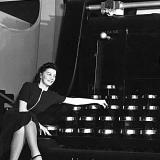
People watching is a common pastime; As a social species, it is instinctive. If you’re a writer, however, it can be the difference between flat featureless prose, and descriptions people can fall in love with. Being a keen observer of people gives you insights into human behaviour which are invaluable, whether you are a writer of fiction fleshing out a believable character, or a non-fiction writer trying to explain in a relatable manner. The best places to observe people have probably always been the bazaars and marketplaces, the ports and public squares, anywhere where people gather to carry out the essential realities of life: commerce, travel, relaxation; Anywhere they are unaware and not self-conscious. This is why airports are a fertile ground to observe a variety of people, and so are malls.
I was at the mall yesterday, and it was full of 20-somethings trying to dress and behave like teenagers. I know this because there are usually real teenagers flooding the corridors around the cinema on weekends, with their fake hair and their awkward perfunctory hugs as they meet and greet the other creatures in parallel packs. In spite of the appearances, this group was different and stiffer (if that was possible).
Children are great subjects to observe because they do the things that adults avoid in public. By the teenage years they’ve already begun to formulate their own rigid social rituals, and adults get more and more straight-jacketed in their public behaviour, for the most part. But children do what comes to mind, rather than what they ought to.
Going down one of the long curving passageways of the mall, a little girl was walking towards us, holding her Mother’s hand. The woman had dishevelled curly hair and was wearing a white full-length dress with an abstract patchy pattern down the front. The girl had straight brown hair and was wearing a short French-striped dress with matching stockings, which like most things looked exceptionally good in the minuscule size. As she walked along, she wasn’t looking ahead or at the shops, but instead at her Mother’s feet, as she tried to match her steps exactly. She was completely engaged and her Mother was smiling in amusement.
A little further along my stroll, a Filipino couple were sitting on bench as their daughter, a girl of few years, with a small ponytail and a green outfit, attempted to put on a dance performance in an empty corner. The dancer kept looking down at her feet to check herself as she continued; An unexpected conscientiousness.
Near the toilets, a father and his pre-teen daughter were walking by. He turned to her and brusquely asked her to wait there by the railing while he used the facilities. She wrapped herself against the large glass pane, her bespectacled face barely resting on the wooden hand-rail. She made no attempt to seem nonchalant; Unlike the other adults waiting there, she simply was.
These little behaviours are a great insight into children, on the surface, but also into how most of us think on deeper levels. You too would be trying to match your steps with your partner, or counting the tiles you walk on, if you allowed yourself to. Maybe you do, in your mind, even though it never shows. These windows into our inner world are a priceless resource for writers.
Adults have their own quirks to observe, some they try to hide, some that have become habits over the years, and a lifetime of accumulated character. On the top level of the mall, a far-eastern woman in a short black outfit walked past, she had a svelte look about her that placed her firmly in the realms of deadly Hong-Kong movie female assassin or mid-level marketing executive in a real-estate company. I tried not to turn around and look, lest I be marked for murder, or worse yet, sold real-estate.
A short, chubby, ginger-haired woman in a large pink t-shirt walked passed, and by the time we had circumnavigated an entire level of the mall and moved to the lower level, we bumped into her again, leaving an opticians. Looking up at the glass railing of the higher level through the central atrium, I spotted the unmistakable black silhouette and adequate legs of the far-eastern woman from before. She was still shuttling between unknown targets on the same level, walking gracefully down the sparsely populated corridors in her relaxed gait.
How people interact within the different relationships and dynamics on display in a public place makes for fascinating viewing. As I rounded a few more corners, two families were passing each other a few metres in front of me. A Russian woman, with husband and daughter in tow, stopped and turned around as she noticed the other couple speaking Russian. She called out to get their attention, and they continued to talk for a while, possibly asking directions or advice on something touristy from the sound of it.
While I was passing by some lingerie stores ahead, a couple in their 30s were sharing a remark about one of the the more outlandish costumes in the shop display; The audible whispers, the leaning in, the shared grin, but only a slight one. Exiting one of the many generic looking fashion stores targeted at teenagers, an older woman was pointing out a girl who just passed by in a faint animal print dress with a sash around her waist, to her younger companion. There was approval in their faces and a mild tinge of something like envy in their backward-angled heads and attentive eyes, about something they wished they could pull off as well as the specimen they had just noticed.
A couple pushing a baby stroller, a stocky man in tan shorts and his petite wife with pulled back hair and a very spa-enhanced face, were offered perfume by the Lebanese salesman manning one of the central stalls on a lower level. After waving him away and walking a few steps, the man looked back and said ‘shukran’ (thank you) with a raised hand, a cultural after-thought. The salesman shouted back ‘affwan’ (welcome) in return, as each party continued with their business.
Our mannerisms and the unique body language we develop, one gesture at a time through life, often defines us and the way people see us. We are unaware of these minor quirks but they play an important part in what makes us recognisable to those who know us, a specific gait, a way we hold ourselves up, a habitual body movement. The smallest twitches can make the biggest impact.
On our way out of the mall we visited the supermarket. At the checkout, a woman with short dark hair and a knee-length dress suit was conversing quietly on her bright blue phone as she was going through. The attendant bagging her groceries was playing safe by keeping things in separate bags. Still cradling the phone on her shoulder and also handling her wallet, she went up to him, put a stray item he had kept aside into the one large bag already prepared and did a strange rotatory motion with her fore arm, trying to tell him to put everything into one bag, while continuing her conversation on the phone uninterrupted.
These scenes were from a single evening stroll that lasted all of 30 minutes. Observing people is fun, and in a mall it can be even more so as you go about your business and notice the other strangers you share the space with for that fleeting time. As a writer, these situations are filled with wonderful observations to make, about humanity and behaviour, about quirks and curiosities. Above all, it’s an unending reservoir of untold stories and unsaid hints. Hints that you can borrow and use in your writing, so that when you introduce your imaginary strangers, you leave readers with the nuances that convince them that they’re spotting an old friend across a crowded street.
Samir
Liked this article? Please share it: ![]()
![]()
![]()
![]()
![]()
![]()



What an interesting read, Samir. You have such an amazing eye for detail; they could almost be characters of a book. MUST.WORK.ON.NOT.MYSELF.ALL.THE.TIME. 🙂
As always, very interesting Samir, describing and observing details is one of your talents, and you´re right, in a mall you can always get to see as many different situations and diverse type of people, meeting in a well organized place, in which I´m sure a constant would be they´re all trying to make their lives better, as it can be just buying something, or just trying to have a good time.
I´m sure you had a good time observing and writing, and I´m as always looing forward to your next post.
Magali
Perfect description of ordinary things that are left unnoticed. Nice work Samir.
Nice thought to share samir!
Nithya
U have really possessed meticulous and shrewd eyes to observe them all.
atleast have the decency to quote sources if you are going to copy
https://www.coursehero.com/file/14559005/CJ140-Unit-4-Lab-Field-Research/
My friend, if “work harder” is meant to be an instruction, I can only suggest you do the same.
Your “source” is a paper submitted in 2016. This post was written by me in 2011, a whole 5 years earlier.
Your suggestion to quote sources should not be suggested to me but to the student who seems to have plagiarized this almost completely.
Thank you for bringing this to my attention.
This is the professor I assume you need to contact: https://www.linkedin.com/in/ife-alexander-caines-71010a140/
And I’m pretty certain this is the student: https://www.linkedin.com/in/manirakiza-joselyne-028217100/
… studying criminal justice no less.
Dear Sameer ,
So it seems Manirakiza Joselyne was keenly observing your posts . hope she did not do research on your other articles .
you are naturally talented and a genius . keep going samir .
regards,
Vijay george